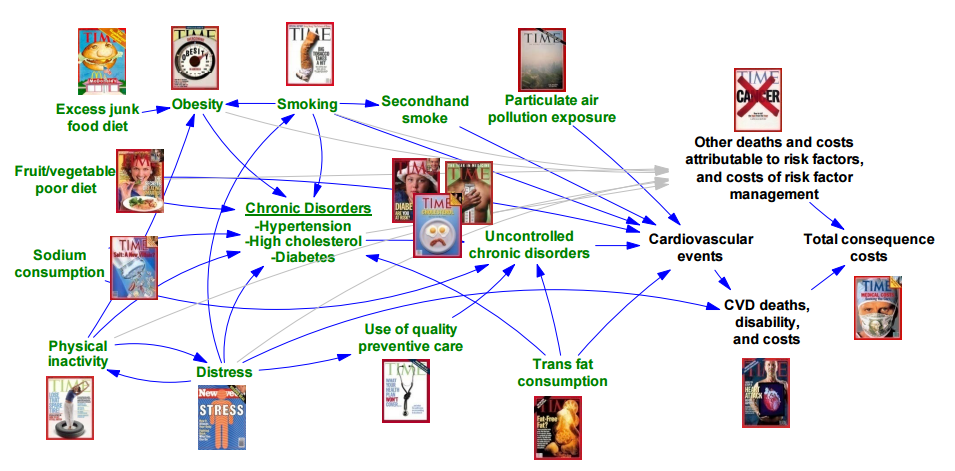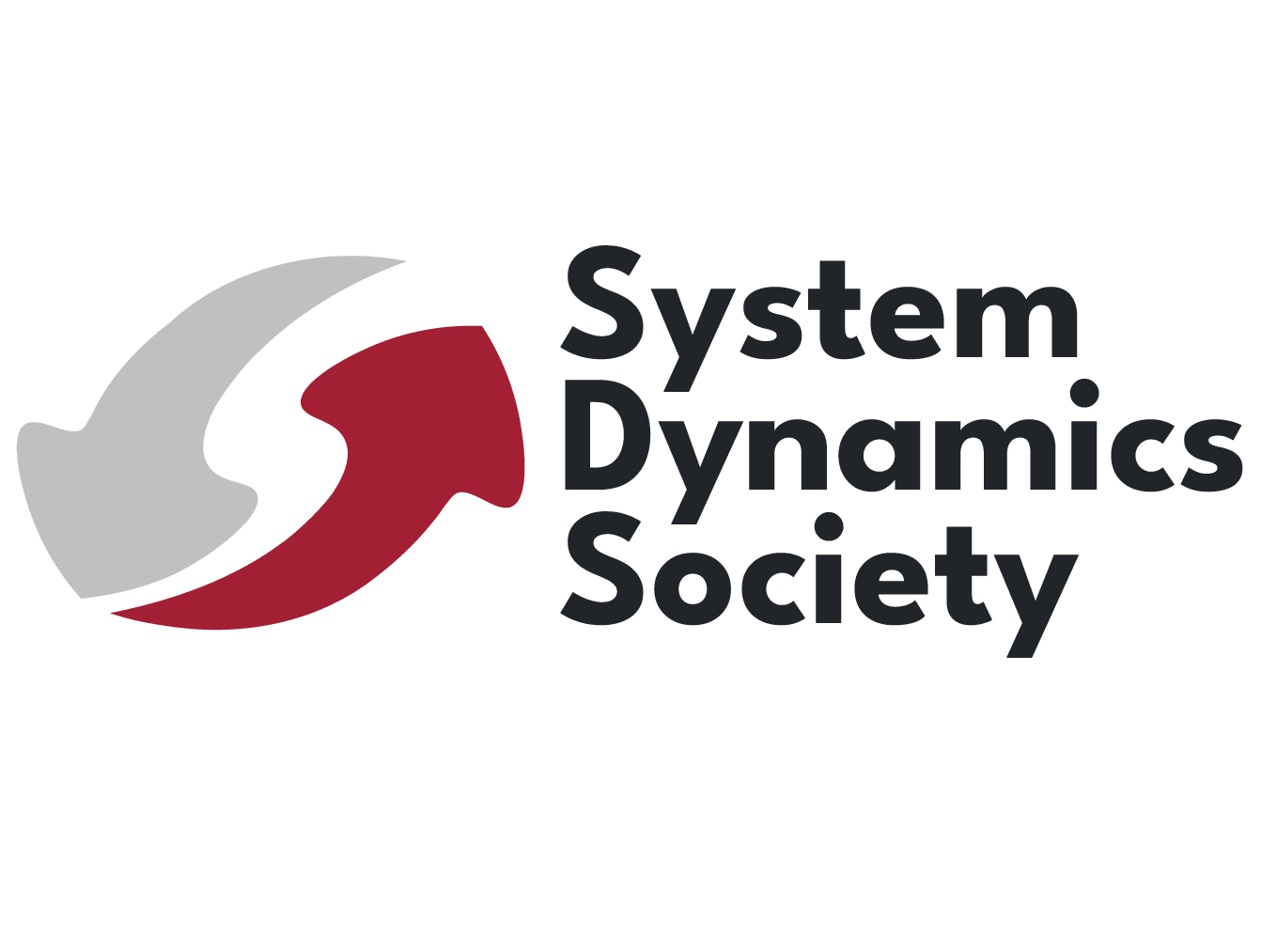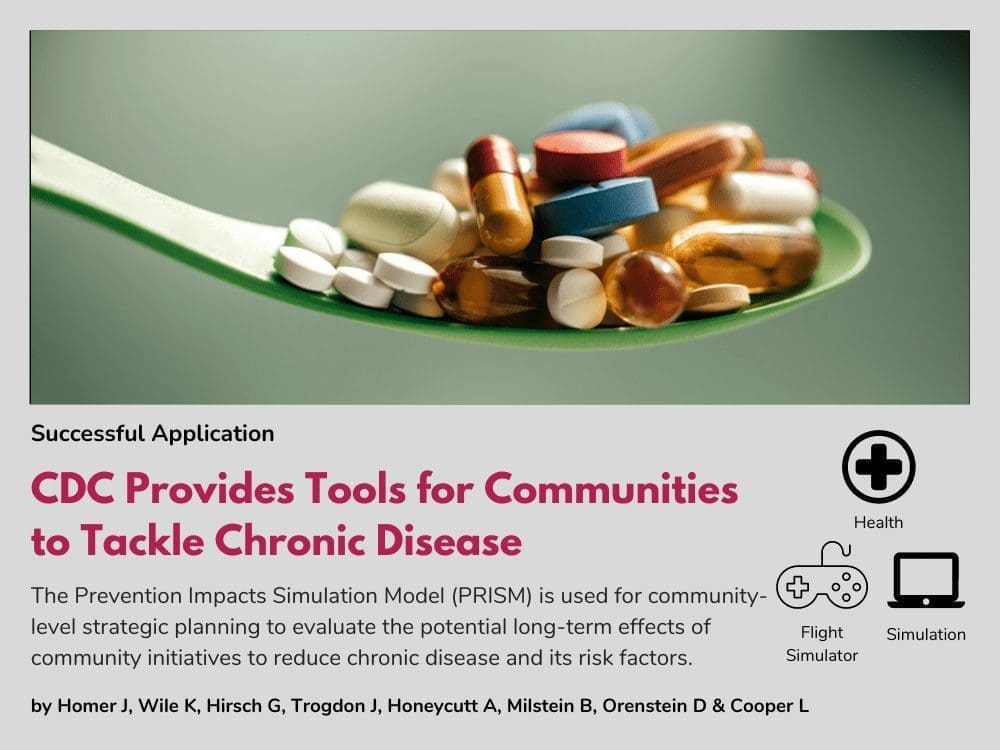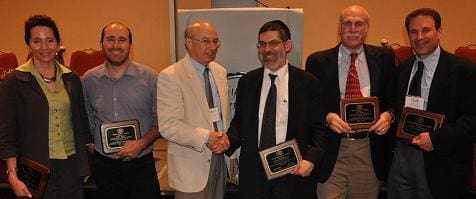CDC Provides Tools for Communities to Tackle Chronic Disease
The Issue You Tackled
At least 70% of deaths among Americans each year are from chronic diseases, and their direct and indirect costs are more than 1 trillion dollars per year. Governmental health agencies are in a position to promote strategies to prevent and manage chronic disease, but identifying the most effective and economical strategies is often difficult. To help health agencies better plan and evaluate interventions, the CDC and the NHLBI funded the creation of the Prevention Impacts Simulation Model (PRISM).
What You Actually Did
PRISM is a relatively large System Dynamics model that is used to simulate trajectories for health and cost outcomes for the entire U.S. population from 1990 to 2040, and has also been applied to represent other national and local populations. Interventions are in several broad areas: medical care, smoking, nutrition and weight loss, physical activity, emotional distress, and particulate air pollution. These interventions act through a range of channels such as access, price, promotion, and regulation. The diseases and conditions modeled in detail include heart disease, stroke, diabetes, hypertension, high cholesterol, and obesity, and the model also accounts for cancers and respiratory diseases related to smoking, obesity, poor nutrition, and physical inactivity.

The Results
The model reports summary measures of mortality and years of life lost as well as the consequent medical and productivity costs of the chronic diseases and conditions modeled. Local and federal health officials have used PRISM throughout its development, and its applications continue to grow in number and variety.
| Name | Prevention Impacts Simulation Model (PRISM) |
|---|---|
| Modelers | Jack Homer, Kristina Wile, Gary Hirsch, Justin Trogdon, Amanda Honeycutt, Bobby Milstein, Diane Orenstein, and Lawton Cooper |
| Client/Participant | Centers for Disease Control and Prevention (CDC) and National Heart, Lung, and Blood Institute (NHLBI) |
| Client Type | Government |
Related Publications
| Using simulation to compare established and emerging interventions to reduce cardiovascular disease risks in the United States. | Download |
| Using simulation to compare 4 categories of intervention for reducing cardiovascular disease risks. | Download |
| From model to action: using a System Dynamics model of chronic disease risks to align community action. | Download |
| A ‘whole of system’ approach to compare options for CVD interventions in counties Manukau. | Download |
| Proceedings from the workshop on estimating the contributions of Sodium reduction to preventable death. | Download |
| A System Dynamics model for planning cardiovascular disease interventions. | Download |
| Simulating and evaluating local interventions to improve cardiovascular health. | Download |
| Modeling the local dynamics of cardiovascular health: risk factors, context, and capacity. | Download |
Did You Know?
System Dynamics Application Award
The System Dynamics Applications Award is presented by the Society every other year for the best “real world” application of system dynamics. The Society awarded its 2011 Applications Award to Jack Homer, Kristina Wile, Gary Hirsch, Justin Trogdon, Amanda Honeycutt, Bobby Milstein, Diane Orenstein and Lawton Cooper for their work Prevention Impacts Simulation Model (PRISM) for Chronic Disease Policymaking. To see the citation that was made by James Lyneis, please follow this link. To see the slides that were used in the 2011 ISDC, please click here. (Jul 2011)
OTHER SUCCESSFUL APPLICATIONS
A Design Value Calculator: A System Dynamics Boardgame
A Design Value Calculator: A System Dynamics Boardgame EXECUTIVE Summary Product design is a specific form of complex innovation that touches all areas of an organization’s management. While entrepreneurs recognise the value of design, they often tend to focus...
The World Bank Uses System Dynamics to Identify Root Causes of Poverty
The World Bank Uses System Dynamics to Identify Root Causes of Poverty EXECUTIVE Summary Madagascar has one of the highest poverty rates in the world. In 2022, an astonishingly three out of every four people in Madagascar lived below the poverty line. Poverty has...
Fast-Track Cities Uses System Dynamics to Enhance HIV Care
Fast-Track Cities Uses System Dynamics to Enhance HIV Care EXECUTIVE Summary Low levels of viral suppression at 69% for people with HIV make it hard to believe the 95% target level will be achieved by 2030 in St. Louis, USA. As a solution, Fast-Track Cities-STL opted...
Upcoming Events

Virtual Career Fair by MINDS & SDS
The Master students in System Dynamics at the University of Bergen, in partnership with the System Dynamics Society, are excited to host an enriching Virtual Career Fair. This event is designed to connect students, alumni, and professionals in the field of System...
Recent Posts
Society Governance Updates
Society Governance Updates Welcome, Allyson! New President Allyson Beall King joined the Policy Council as our 2024 President. Her primary role is as director of the Washington State University School of the Environment, which focuses on regional ecologies and our...
Call for Presenters: Seminar Series
Call for Presenters: Seminar Series We at the System Dynamics Society are continually seeking vibrant and knowledgeable presenters for our ongoing Seminar Series. As we unfold the calendar, there’s always a place for more insights, experiences, and expertise to enrich...
Honoring Excellence: A Glimpse into the Awards of the International System Dynamics Conference
Honoring Excellence: A Glimpse into the Awards of the International System Dynamics Conference The International System Dynamics Conference brings together experts, practitioners, and students to exchange ideas, showcase real-world applications, and celebrate...
Join us
OTHER SUCCESSFUL APPLICATIONS
A Design Value Calculator: A System Dynamics Boardgame
A Design Value Calculator: A System Dynamics Boardgame EXECUTIVE Summary Product design is a specific form of complex innovation that touches all areas of an organization’s management. While entrepreneurs recognise the value of design, they often tend to focus...
The World Bank Uses System Dynamics to Identify Root Causes of Poverty
The World Bank Uses System Dynamics to Identify Root Causes of Poverty EXECUTIVE Summary Madagascar has one of the highest poverty rates in the world. In 2022, an astonishingly three out of every four people in Madagascar lived below the poverty line. Poverty has...
Fast-Track Cities Uses System Dynamics to Enhance HIV Care
Fast-Track Cities Uses System Dynamics to Enhance HIV Care EXECUTIVE Summary Low levels of viral suppression at 69% for people with HIV make it hard to believe the 95% target level will be achieved by 2030 in St. Louis, USA. As a solution, Fast-Track Cities-STL opted...
Recent Posts
Society Governance Updates
Society Governance Updates Welcome, Allyson! New President Allyson Beall King joined the Policy Council as our 2024 President. Her primary role is as director of the Washington State University School of the Environment, which focuses on regional ecologies and our...
Call for Presenters: Seminar Series
Call for Presenters: Seminar Series We at the System Dynamics Society are continually seeking vibrant and knowledgeable presenters for our ongoing Seminar Series. As we unfold the calendar, there’s always a place for more insights, experiences, and expertise to enrich...
Honoring Excellence: A Glimpse into the Awards of the International System Dynamics Conference
Honoring Excellence: A Glimpse into the Awards of the International System Dynamics Conference The International System Dynamics Conference brings together experts, practitioners, and students to exchange ideas, showcase real-world applications, and celebrate...
Upcoming Events

Virtual Career Fair by MINDS & SDS
The Master students in System Dynamics at the University of Bergen, in partnership with the System Dynamics Society, are excited to host an enriching Virtual Career Fair. This event is designed to connect students, alumni, and professionals in the field of System...



